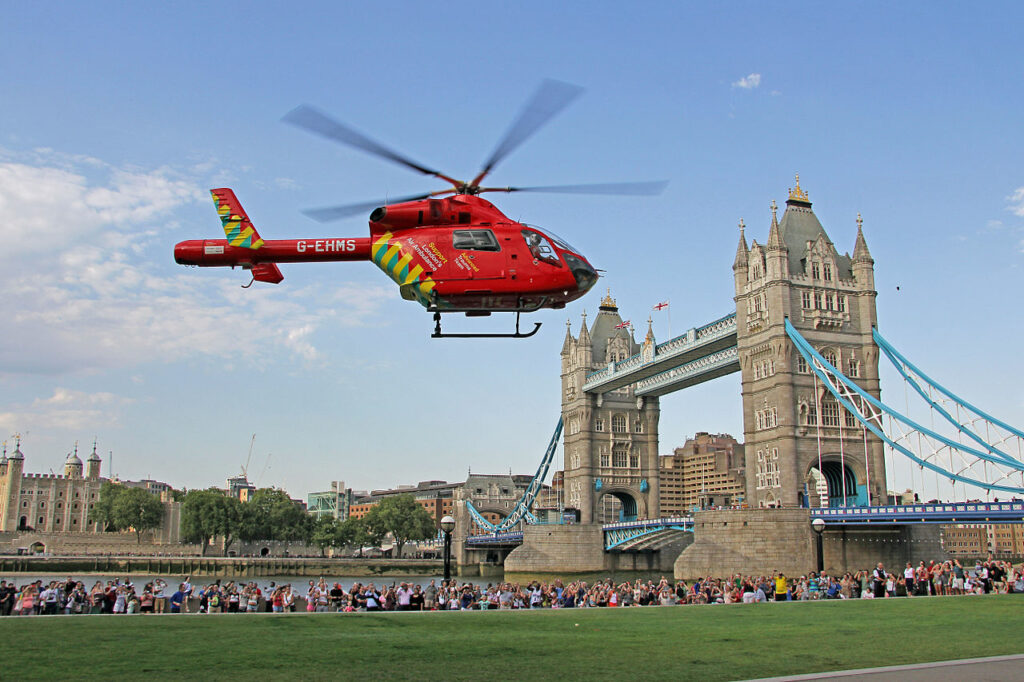Emergency services in Gloucestershire, Worcestershire, Somerset, Sussex and London are to benefit from a share of more than £200,000 of funding. The purpose of the funding is to allow air ambulances to land more safely in poor weather conditions.
5 regions selected
Almondsbury Helicopter Airbase, Strensham Airbase, Henstridge Airfield, Royal Sussex County Hospital and King’s College Hospital were all selected as successful applications of the Global Navigation Satellite System (GNSS) Programme.
The programme is run by the UK Civil Aviation Authority and Department for Transport.
Funding will support their blue light landing sites to put in place new systems to allow helicopters to operate in challenging conditions that they previously would not have been able to, which will save lives in critical situations.
The GNSS Programme, in its third phase, has already provided thousands of pounds needed to deliver safety improvements.
The Programme focuses on improving flight safety by helping organisations implement new approach procedures using satellite technology, much like GPS in your car.
CAA and Ministerial comments
Rob Bishton, Group Director of Safety and Airspace Regulation at the UK Civil Aviation Authority, said:
“Emergency services will benefit from improved flight safety and increased resilience for helicopter services, which will allow landings to take place in severe weather and challenging conditions– potentially saving lives in critical situations.”
[monsterinsights_popular_posts_inline]
“We’ll work with applicants to deliver these benefits across the UK and enable the GNSS procedures to be implemented safely and efficiently.”
Minister for Aviation, Baroness Vere, said: “The UK continues to harness the latest technologies and draw on the strengths of our space industry to boost flight safety.
“This funding will help ensure air ambulance crews in regions across the country can land in challenging conditions, so more patients receive urgent care when they need it.”
GNSS Programme
The dedicated GNSS Facilitation Team at the UK Civil Aviation Authority will also help guide sponsors and emergency service operators through the streamlined Airspace Change Process, ensuring a smooth and efficient transition to this innovative system.
The scheme received many applications for the third phase of the GNSS Programme, making the selection process highly competitive.
After careful consideration, the UK Civil Aviation Authority and Department for Transport chose to allocate resources to organisations covering five helicopter landing sites.
These are made specifically to emergency services because of the benefits it will bring to people in their surrounding communities.
The GNSS Programme has already demonstrated its ability to improve flight safety, particularly when landing in poor weather conditions.
The potential benefits are even greater as it will enable air ambulances to land safely in weather that they would not previously be able to.
About air ambulance operators
Air ambulance services in England are typically provided by charities and private companies. These services use helicopters or fixed-wing aircraft to transport patients in need of urgent medical care to hospitals or medical facilities.
Services operate in specific regions of England and provide rapid response to medical emergencies, often working closely with the local ambulance service and hospital network.
In addition to charities, several private companies also provide air ambulance services in England. These companies typically provide medical repatriation services, transporting patients back to their home country or to a medical facility of their choice.
Air ambulance services in England are often called upon to respond to emergencies such as road accidents, heart attacks, strokes, and other medical emergencies.
These services are staffed by highly trained medical professionals, including doctors and paramedics, who are equipped with advanced medical equipment and technology to provide critical care in-flight.
Most air ambulance services in England are funded by donations from the public, corporate sponsors, and other charitable organizations.









